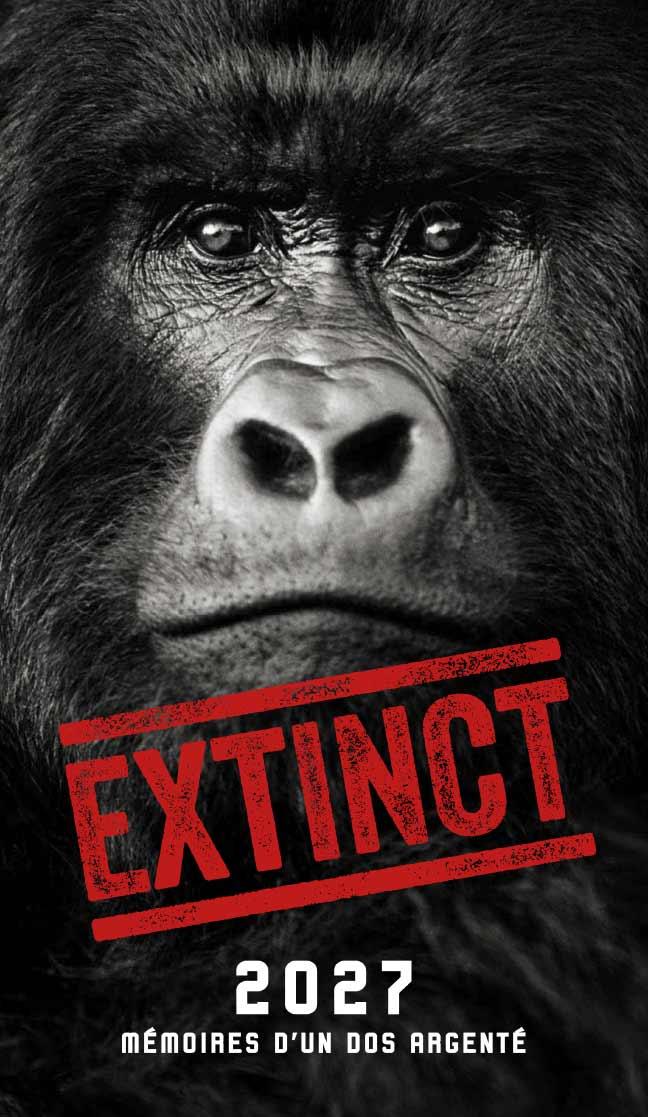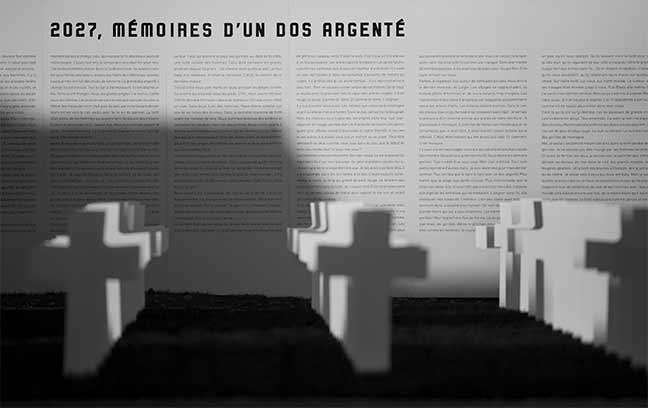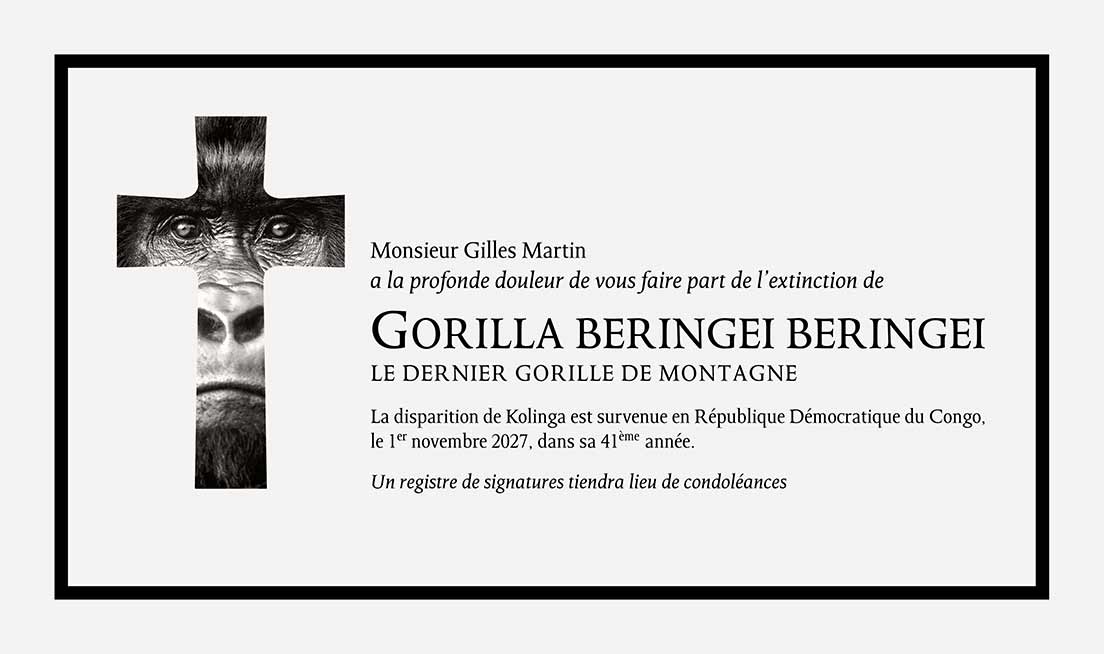




The front face of the Memorial displays the text of the Memoirs of Kolinga. The rear face is used as a giant collection of signatures for visitors who wish to write a message in memory of Kolinga.

The cemetery.

The visual of the Chronology of Kolinga is on the right face of the Memorial
See the chronology of Kolinga

In the funeral parlour, members of the public can spend a moment in silence before Kolinga’s coffin and view an exhibition of black-and-white photographs.
Photo credit for the 2 images produced using a fisheye lens:
Laurence Denouveaux

First presentation of the Happening “2027 Memoirs of a silverback” at the International Festival of Animal and Nature Photography of Montier-en-Der.
Artivist
Happening
What is a happening?
It was the abstract painter Allan Kaprow who came up with the term in 1957. He used it to describe an event or an artistic performance that involved active participation by the public.
In the following decade, a handful of USA artists tried their hand at that artistic form, and New York became the cradle of the first happenings. The works mixed genres, increased dimensions tenfold, animated what had been static, and caused surprise with eclecticism and the previously never seen. They stimulate the senses of the public, which becomes a full player in the performance. An important turning point came in the 1960s in Germany, with a new wave of more subversive happenings. Those happenings showcased – and, by doing so, they brought into question – traditional values and societal underpinnings.
Canvassing the public is even more aimed at conscience. The happening wants to call forth a reaction in one way or another: shock, displease, seduce, provoke – at any rate: engage with people! Thereafter, each conscience is free to use its critical faculty, examine its personal convictions, and choose its own position.
That is the approach that defines the happenings of today: art is used as a powerful means of expression to alert public opinion to great causes, such as the decline of biodiversity.
Thus, more than a simple exhibition, the happening “2027 – Memoirs of a silverback” engages with you through its visual and conceptual impact. The funerary symbolism on which the event rests marks spirits and inevitably provokes an emotion.
Scenario and photography by Gilles Martin
In the media…
“For me, Gilles Martin’s Memorial Exhibition on the last silverback was like an earthquake. The scenography was extremely explicit: there is a warning message before you go in to look upon the coffin…There followed a funeral ceremony for the last gorilla, who died in 2027. Terribly poignant. A message that was strong, yet subtle. Gilles Martin manages the feat of brilliantly renewing his approach. That is not something given to everyone. A gigantic work.” Daniel Gérard
An extinction foretold
The scientific community is unanimous: several species of primates are at risk of becoming extinct in their natural habitats in the next 10 to 15 years. The Orang Utan, the Bonobo, the Chimpanzee, and the Gorilla are amongst those species threatened with extinction in the short term if exceptional protection measures are not put in place as a matter of utmost urgency.
Based on that finding and in order to give a jolt to consciences, the photographic Happening “2027 – Memoirs of a silverback” projects spectators into the future: on 1st November 2027, the last representatives of the mountain gorilla species called Gorilla beringei beringei dies, killed by poachers.
A sanctuary to retrace the existence of the silverback
The Memorial Exhibition “2027 – Memoirs of a silverback” is a funerary sanctuary set up in honour of Kolinga the silverback. Before he died, he left to living beings the memoirs of his life in the Congo cloud forest. Out of solidarity, several animal species have chosen to come out of the shadows to express their anguish to find themselves in turn threatened with extinction.
Obituary notice

To mark spirits and to ensure that the public is anchored in 2027, the presentation panel for the exhibition is a giant obituary notice that announces the extinction of the last mountain gorilla. The staging, heavy with symbolism, calls forth emotion, and, like a deforming mirror, it propels us – regardless of our beliefs – to our own deaths or to those of beings who are dear to us. Humans and gorillas share almost 99% of their genes; that genetic closeness reinforces the troubling sense of belonging.
Cemetery
The cemetery is made up of 130 crosses (or more, depending on the space available). The crosses are identical and aligned in neat rows, as in a USA war cemetery. The event can be held both inside and outside.
Memorial
The memorial is set opposite the cemetery. On its front face, spectators can reach the memoirs of Kolinga, the dead gorilla. The text is written in the first person. The story: the Democratic Republic of Congo (DRC), November 2027. Kolinga, the last representative of the mountain gorillas, has just been killed by a hail of bullets from a Kalashnikov gun fired by a poacher. Before dying, Kolinga calls to mind his past. He tells his story, his childhood, his survival in the forest, and the extinction of his fellows…
In his posthumous memoirs, Kolinga delivers an unending indictment against humans, who are responsible for the extinction of his species; he brings to bear a critical gaze on the devastating impact of human activities on the Earth. In one century, Homo sapiens has disrupted the planet’s ecosystems faster than at any other time in history. Humans are the reason behind climate changes and the sixth planet-wide extinction.
That scenario can soon become reality!
A fairy story or a tale foretold? It is up to us to decide – for the posthumous memoirs of the silverback rest on ecological, biological, epidemiological, and geopolitical data that are realistic. By way of proof, the gorilla photographed by Gilles Martin, presented in effigy on each cross, was really killed by poachers two years after those images were made, in Virunga National Park in the DRC.
Kolinga’s chronology, 1986 - 2027
The chronology uses twenty dates to takes us through Kolinga’s life, from birth in Virunga National Park in the Democratic Republic of Congo to death in 2027. Through his life as head of a clan, we learn of the ravages of civil war, the retreat of the forest, the threat of black gold, and the final combat of those primates against the Ebola virus.
A collection of signatures
As a response to the funerary symbolism of the obituary notice, a giant collection of signatures has been set up behind the memorial so that visitors can bear witness and express a thought in memory of the late gorilla Kolinga.
Funeral parlour
An imposing USA coffin, silver in colour, stands in the centre of the funeral parlour. The coffin holds the remains of Kolinga. On the walls, Gilles Martin has set up an exhibition of 60 black-and-white prints.
30 photographs of mountain gorillas taken in Virunga National Park in the DRC, Volcanoes National Park in Rwanda, and Bwindi Impenetrable National Park in Uganda.
Kolinga’s name comes from the Lingala language, and means “Love”.
30 photographs of species threatened with extinction, representing different types of animals across the six continents: mammals, birds, insects, reptiles, and amphibians. The animals that are most emblematic of wild fauna, such as the Tiger, the Elephant, the Polar Bear, and Emperor Penguin, the Komodo Dragon, the Japanese Crane, the Rhinoceros, the Humpbacked Whale, the Abyssinian Wolf, and the Grizzly Bear, are showcased. The photographs in the exhibition were taken in natural settings.
Happening
The event can take place on the date of the private view. The public invited to the Happening “2027 – Memoirs of a silverback” will take part in Kolinga’s symbolic burial. Initially, guests spend a moment of silence before the gorilla’s remains in the funeral parlour. Next, they form a cortege that follows the coffin, which is carried by six bearers dressed in black. The procession leaves the funeral parlour and ends at Kolinga’s tomb. Before burial, solemn homage is paid to the gorilla by a storyteller reciting Kolinga’s memoirs. To close the ceremony, Gilles Martin gives a funeral oration to honour the memory of Kolinga one last time.
Extract from Kolinga’s memoirs
“I, mountain gorilla, I am the last one. After me, there is nothing more. I am alone, and my name is lost. I had a name, for those of my clan. But I will not give it. I will carry this with me when I fade away. Humans do not deserve to know it. What good would it do ? Humans have just one name for everything : death.
The last of the trees of the forest will fall on the last of the great apes. And it’s me… I am all the whole of the species and I am the end. I am no more than a shadow, no more than a blast of air, but before the tree falls, time will permit me to tell you a little of my story.
I was born in the forest. We gorillas, we were as numerous as the great trees. Where the sun sets, our people went right the way to the great blue expanse. Where the sun rises, it is the great escarpment that marked the end of our land. We, the great gorillas from volcanoes, were in the centre of this world. Gorillas of the misty forest..”
Musical accompaniment for the Happening
Wolfgang Amadeus Mozart: Requiem in D minor, KV 626.
Description and technical details
A press pack is available from Gilles Martin, as is a pamphlet setting out all the technical details for the set-up, the organisation of the Happening, hire rates, transport, etc.
Click to access
Gilles Martin’s limited editions Silverback-Memorial Limited Editions


